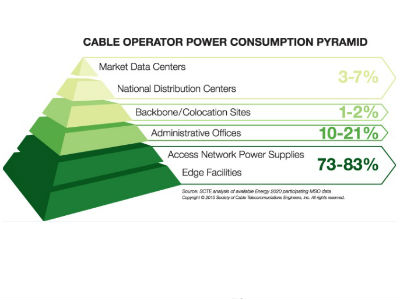Study Pinpoints Cable’s Energy-Saving Hotspots

The Society of Cable Telecommunications Engineers (SCTE) issued the results of a new report finding that the greatest opportunity to cut energy costs in cable networks is from the headend or hub to the home.
SCTE noted that between 73% to 83% of cable’s overall energy consumption is via hubs and headends, as well as from the access network power supplies that are amping up the active equipment on the hybrid fiber/coax network.
SCTE presented the results of the analysis, generated from a cross-section of major MSOs, on Tuesday (February 3) at an Energy 2020 session in Herndon, Va. Introduced last June and outlined at last year’s SCTE Cable-Tec Expo in Denver, the SCTE Energy 2020 initiative is targeting a 20% reduction of power consumption on a unit basis, a 15% energy cost reduction on a unit basis, and a 10% cut in grid dependency, and to optimize the power used in headends and data centers by 25%. Balan Nair, the EVP and CTO of Liberty Global was recently named co-chair of Energy 2020, joining John Schanz, EVP and chief network officer of Comcast Cable.
“While devices in the edge facilities and in the network individually are not the greatest consumers of power in our networks, the sheer number of those devices makes those areas high priorities for the reduction of consumption and cost on a per-unit basis,” said Daniel Howard, senior vice president and CTO of SCTE, in a statement.
SCTE, citing data usage projections from Cisco Systems Inc. and energy cost estimates from the United States Department of Energy, said annual cable energy costs could rise from more than $1 billion currently to as much as $4 billion per year by 2020.
Howard said the findings represent a two-pronged cost-avoidance opportunity for operators and vendors: the replacement of existing plant and headend gear with more efficient equipment as part of normal operational maintenance, as well as the design and deployment of more efficient equipment as operators migrate to CCAP (converged cable access platform), Remote PHY, PON and other architectures.
In the report, SCTE also found that market data centers and national distribution centers represent 3% to 7% of the industry’s power usage, despite the presence of servers, video processing equipment, routers and other higher-consumption equipment. Backbone and co-location sites (1% to 2%) and administrative offices (10% to 21%) represent the remainder.
Multichannel Newsletter
The smarter way to stay on top of the multichannel video marketplace. Sign up below.
